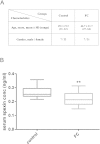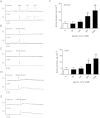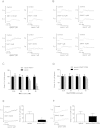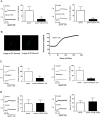Spexin Enhances Bowel Movement through Activating L-type Voltage-dependent Calcium Channel via Galanin Receptor 2 in Mice
- PMID: 26160593
- PMCID: PMC4498193
- DOI: 10.1038/srep12095
Spexin Enhances Bowel Movement through Activating L-type Voltage-dependent Calcium Channel via Galanin Receptor 2 in Mice
Abstract
A novel neuropeptide spexin was found to be broadly expressed in various endocrine and nervous tissues while little is known about its functions. This study investigated the role of spexin in bowel movement and the underlying mechanisms. In functional constipation (FC) patients, serum spexin levels were significantly decreased. Consistently, in starved mice, the mRNA of spexin was significantly decreased in intestine and colon. Spexin injection increased the velocity of carbon powder propulsion in small intestine and decreased the glass beads expulsion time in distal colon in mice. Further, spexin dose-dependently stimulated the intestinal/colonic smooth muscle contraction. Galanin receptor 2 (GALR2) antagonist M871, but not Galanin receptor 3 (GALR3) antagonist SNAP37899, effectively suppressed the stimulatory effects of spexin on intestinal/colonic smooth muscle contraction, which could be eliminated by extracellular [Ca(2+)] removal and L-type voltage-dependent Ca(2+) channel (VDCC) inhibitor nifedipine. Besides, spexin dramatically increased the [Ca(2+)]i in isolated colonic smooth muscle cells. These data indicate that spexin can act on GALR2 receptor to regulate bowel motility by activating L-type VDCC. Our findings provide evidence for important physiological roles of spexin in GI functions. Selective action on spexin pathway might have therapeutic effects on GI diseases with motility disorders.
Figures






Similar articles
-
Palmitate differentially regulates Spexin, and its receptors Galr2 and Galr3, in GnRH neurons through mechanisms involving PKC, MAPKs, and TLR4.Mol Cell Endocrinol. 2020 Dec 1;518:110991. doi: 10.1016/j.mce.2020.110991. Epub 2020 Aug 22. Mol Cell Endocrinol. 2020. PMID: 32841709 Review.
-
Spexin Diminishes Atrial Fibrillation Vulnerability by Acting on Galanin Receptor 2.Circulation. 2024 Jul 9;150(2):111-127. doi: 10.1161/CIRCULATIONAHA.123.067517. Epub 2024 May 10. Circulation. 2024. PMID: 38726666
-
Coevolution of the spexin/galanin/kisspeptin family: Spexin activates galanin receptor type II and III.Endocrinology. 2014 May;155(5):1864-73. doi: 10.1210/en.2013-2106. Epub 2014 Feb 11. Endocrinology. 2014. PMID: 24517231
-
Levels of spexin and its receptors GALR2 and GALR3 in the hypothalamus and ovary of letrozole-induced polycystic ovary syndrome in rats.Biochem Biophys Res Commun. 2022 Oct 30;627:207-213. doi: 10.1016/j.bbrc.2022.08.059. Epub 2022 Aug 27. Biochem Biophys Res Commun. 2022. PMID: 36055012
-
An update on galanin and spexin and their potential for the treatment of type 2 diabetes and related metabolic disorders.Peptides. 2024 Jan;171:171096. doi: 10.1016/j.peptides.2023.171096. Epub 2023 Sep 14. Peptides. 2024. PMID: 37714335 Review.
Cited by
-
Peripheral Spexin Inhibited Food Intake in Mice.Int J Endocrinol. 2020 Aug 5;2020:4913785. doi: 10.1155/2020/4913785. eCollection 2020. Int J Endocrinol. 2020. PMID: 32831833 Free PMC article.
-
Circulating spexins in children with obesity: relation to cardiometabolic risk.Eur J Clin Nutr. 2022 Jan;76(1):119-125. doi: 10.1038/s41430-021-00912-7. Epub 2021 Apr 13. Eur J Clin Nutr. 2022. PMID: 33850315
-
The Neuropeptide Spexin Promotes the Osteoblast Differentiation of MC3T3-E1 Cells via the MEK/ERK Pathway and Bone Regeneration in a Mouse Calvarial Defect Model.Tissue Eng Regen Med. 2022 Feb;19(1):189-202. doi: 10.1007/s13770-021-00408-2. Epub 2021 Dec 24. Tissue Eng Regen Med. 2022. PMID: 34951679 Free PMC article.
-
Uncovering the Mechanisms of Chinese Herbal Medicine (MaZiRenWan) for Functional Constipation by Focused Network Pharmacology Approach.Front Pharmacol. 2018 Mar 26;9:270. doi: 10.3389/fphar.2018.00270. eCollection 2018. Front Pharmacol. 2018. PMID: 29632490 Free PMC article.
-
Spexin role in human granulosa cells physiology and PCOS: expression and negative impact on steroidogenesis and proliferation†.Biol Reprod. 2023 Nov 15;109(5):705-719. doi: 10.1093/biolre/ioad108. Biol Reprod. 2023. PMID: 37658762 Free PMC article.
References
Publication types
MeSH terms
Substances
LinkOut - more resources
Full Text Sources
Other Literature Sources
Medical
Miscellaneous

